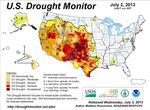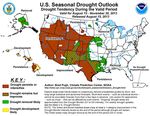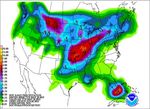Weather & Hydrologic Forecasting for Water Utility Incident Preparedness and Response
←
→
Page content transcription
If your browser does not render page correctly, please read the page content below
Weather & Hydrologic Forecasting for
Water Utility Incident Preparedness and Response
Maintaining awareness of current and projected weather
and hydrologic conditions is important as your drinking
water or wastewater utility prepares for a natural disaster.
The following information sources forecast several types
of weather events over various time spans, ranging from
real-time weather (i.e., today’s forecast) to 3 months.
The forecasts begin with the identification of regional and
local hazard outlooks across the nation, then become
event-specific. Some of the resources can be found on
NOAAWatch.gov, NOAA’s All-Hazard Monitor webpage that
highlights various forecasting tools and describes weather
events in detail. To explore the tools below, click on the title
or image to be linked directly to the product’s website.
FEMA
National Weather Hazards All-Hazards
Day 1
This map links to state and county level National Weather Service
(NWS) watches, warnings, advisories and other similar information
on events including floods, high winds, severe thunderstorms and
winter storms. This page also serves as the National Weather Service
www.weather.gov homepage and many additional information sources are linked
from this page. Some of these resources are described later in this
document, but you may also want to search the site to find a new
product that could benefit your utility.
National Forecast Charts All-Hazards
Day 1 - Day 3
The Weather Prediction Center’s National Forecast Charts provide an
overview of expected weather with an emphasis on certain hazardous
and significant weather. The one, two and three-day forecasts are
summaries of event-specific NOAA forecasts and include current
and projected threats, such as: severe thunderstorms and tornados;
tropical storms and hurricanes; heavy snow, sleet, freezing rain and
www.hpc.ncep.noaa.gov/national_
forecast/natfcst.php flash flooding.Weather & Hydrologic Forecasting for Water Utility Incident Preparedness and Response
US Hazards Assessment All-Hazards
Day 3 - Day 14
The Hazards Assessment is intended to provide emergency
managers, planners, forecasters and the public advance notice of
www.cpc.ncep.noaa.gov/products/ potential hazards related to climate, weather and hydrological events.
expert_assessment/threats.shtml
The first outlook illustrates projected regional and local hazards
from day 3 to day 7 and the second outlook from day 8 to day 14.
The map accounts for several weather events, including: severe
drought, enhanced wildfire risk, flooding, heavy snow and abnormal
temperatures.
Quantitative Precipitation Forecasts Rainfall
Day 1 - Day 7
Quantitative Precipitation Forecasts (QPFs) illustrate expected
precipitation amounts for various time scales. For days 1, 2 and 3,
forecasts are available in 6-hour increments. Precipitation totals are
available for one day, two day, three day, five day and seven day
forecasts, which may be helpful in preparing for excessive rainfall
www.wpc.ncep.noaa.gov/qpf/qpf2. accumulation. For days 4-5 and 6-7, 48-hour time period forecasting
shtml is provided.
Excessive Rainfall Forecasts Rainfall
Day 1 - Day 3
This map identifies areas across the nation where rainfall is expected
to exceed flash flood guidance; provided in one, two and three-day
forecasts.
http://www.hpc.ncep.noaa.gov/qpf/
excess_rain.shtml
River Observations, Forecasts and Experimental
Long-Range Flood Risk River Gage Flooding
Day 1 - 3 months
These three maps locate all river gages within the United States,
highlighting those that are currently flooding (Observations), are
expected to flood in the next several days (Forecasts) or are at risk
for flooding in the next three months (Experimental Long-Range Flood
Risk). All maps have the ability to select a specific gage and view the
water.weather.gov/ahps/index.php current and projected river levels, and in the case of the Long-Range
Flood Risk, the probability of exceeding river flood stage levels.Weather & Hydrologic Forecasting for Water Utility Incident Preparedness and Response
U.S. Spring Flood Risk Flooding
Seasonal
This resource, which is only available in the spring, provides a
nationwide seasonal flood outlook and includes a detailed explanation
of causes and potential impacts. As flooding can affect much of the
United States, this resource could be helpful for water utilities across
the country as they look ahead and plan for flood season.
www.nws.noaa.gov/hic/nho/
U.S. Drought Monitor Drought
Day 1 - 3 months
This resource illustrates and categorizes current drought conditions
across the United States and notes whether those conditions are
expected to result in short-term (6 months)
drought impacts. The Drought Monitor scale, ranging from D0 to D4,
is based on the historical frequency of drought for a particular area,
with D1 conditions expected to occur about every 12 years and D4
droughtmonitor.unl.edu/ about every 50 years. This map may be useful for utilities developing
drought preparedness or mitigation plans.
U.S. Seasonal Drought Outlook Drought
Day 1 - greater than 3 months
This resource provides a more long-term drought outlook and an
explanation of how drought conditions are predicted to change over
the upcoming three months.
http://www.cpc.ncep.noaa.gov/
products/expert_assessment/sdo_
summary.html
For more information and tools related to drought, visit the U.S. Drought Portal
(www.drought.gov). Helpful information sources available on this site are the
quarterly Regional Assessments, outreach documents which outline local
conditions and drought impacts for general audiences.Weather & Hydrologic Forecasting for Water Utility Incident Preparedness and Response
Building Relationships with Your Local
NOAA Weather Forecasting Office
Consult the StormReady webpage to determine your local National Weather
Service forecasting office (http://www.stormready.noaa.gov/contact.htm). Your
local office may be able to provide location-specific forecasts and alerts during
severe weather events. The Warning Coordination Meteorologist at local
Weather Forecast Offices (WFOs) can provide utilities with important weather
preparedness information. The local Service Coordination Hydrologist (SCH)
can also be a helpful partner by providing information about NWS hydrologic
capabilities and providing technical guidance.
StormReady • http://www.stormready.noaa.gov/
One way to foster the relationship with the local WFO is to explore becoming a StormReady utility.
StormReady is a nationwide community preparedness program that uses a grassroots approach to help
communities develop plans to handle all types of severe weather. In this context, organizations that
qualify as “communities” may include, but are not limited to: counties, commercial sites and facilities
such as water utilities. The program encourages organizations to take a new, proactive approach
to improving local hazardous weather operations by providing emergency managers with clear-cut
guidelines on how to improve their hazardous weather operations.
To be officially StormReady, an organization must:
• Establish a 24-hour warning point and emergency operations center,
• Have more than one way to receive severe weather warnings and forecasts and to alert the public,
• Create a system that monitors weather conditions locally,
• Promote the importance of public readiness through community seminars and
• Develop a formal hazardous weather plan, which includes training severe weather spotters and
holding emergency exercises.
StormReady Supporters are local entities that do not qualify for full StormReady recognition, yet
promote the principles of the StormReady program into their severe weather safety and awareness
plans. Entities may be eligible as a StormReady Supporter, based on the bylaws of the state NWS
StormReady Advisory Board and the endorsement from local emergency management.
While meeting with your local National Weather Service forecasting office, you may wish to
discuss with them their Emergency Alert System (EAS) procedures. These offices are responsible
for issuing local non-weather emergency messages, including Civil Danger Warnings, which
can include water contamination incidents. This mechanism could greatly assist water utilities in
broadcasting public notifications, such as Boil Water and Do Not Drink advisories.
FEMA’s Integrated Public Alert & Warning System (IPAWS) utilizes EAS and other methods to deliver
local, regional and national alerts during an emergency. Contact your local or state emergency
management agency to discuss this platform as a means of broadcasting water use advisories.
http://www.nws.noaa.gov/om/NWS_EAS.shtml
http://www.fema.gov/integrated-public-alert-warning-systemWeather & Hydrologic Forecasting for Water Utility Incident Preparedness and Response
Helpful Tools
USGS WaterAlert • water.usgs.gov/wateralert/
Sign up for WaterAlert and the U.S. Geologic Survey (USGS) will send you an email or text message alert
when the river gages that you have identified surpass specified parameters. The basic real-time parameters
supported by WaterAlert are: surface water (streamflow, gage height, lake/reservoir level, stream level,
stream velocity); groundwater (water level depth and elevation); water quality (water temperature, specific
conductance, pH, dissolved oxygen, salinity, turbidity) and total precipitation.
USGS WaterNow • water.usgs.gov/waternow/
Another way to determine these real-time parameters is to text or email a unique gage or well site number to
USGS WaterNow and receive descriptions of current conditions. This method does not send automatic alerts,
but could be useful for occasional inquiries or for work in the field.
USGS Flood Inundation Mapper • wim.usgs.gov/FIMI/FloodInundationMapper.html
This interactive map allows users to select individual river gages to view observed, current and predicted
water levels over a ten-day time frame, as well as historical flood levels. A unique capability of this tool is that
it allows users to adjust an “Estimated Flood Conditions” scale to see clearly on a map the impact of varying
flood levels on a particular location.
USGS WaterWatch • waterwatch.usgs.gov/
Compare today’s conditions with historical data for streamflow levels, drought, flood and past flow/runoff.
Additional Resources
National Hurricane Center
Day 1
Tropical Weather/Hurricane • www.nhc.noaa.gov
During active hurricanes and tropical cyclones, the National Hurricane Center (NHC) page provides predicted
storm path and timing, precipitation amounts, storm surge estimates, tropical storm wind probabilities and other
useful information to prepare your utility for the storm.
Storm Surge Prediction
Day 1 - Day 3
Storm Surge • www.nws.noaa.gov/mdl/psurge/active.php
Measured in feet above normal tide level, this map illustrates storm surge heights that have a ten percent chance
of being exceeded within the next three days.
Storm Prediction Center
Day 1 - Day 8
Severe Thunderstorms and Tornadoes • www.spc.noaa.gov/
The Storm Prediction Center (SPC) provides forecasts and watches for severe thunderstorms and tornadoes
across the United States. The SPC also produces forecasting tools for heavy rain, snow and fire events.Weather & Hydrologic Forecasting for Water Utility Incident Preparedness and Response
Additional Resources (continued)
Weather Prediction Center
Day 1 - Day 7
Various Products, All-Hazards • http://www.wpc.ncep.noaa.gov/
The Weather Prediction Center (WPC) provides forecasts for heavy rain and winter weather events over the
next seven days. Products also include current and predicted pressure systems and weather fronts.
Climate Prediction Center
Day 6 - 3 months
Various Products, All-Hazards • www.cpc.ncep.noaa.gov/
The Climate Prediction Center’s (CPC) tools illustrate predicted climate variability in time scales ranging from
one week to three months.
Tsunami Warnings
Day 1
Tsunami • www.tsunami.gov/
This website provides active tsunami warnings for the entire United States.
Earthquakes
Past 7 days
Earthquake • earthquake.usgs.gov/earthquakes/map/
This site provides information on earthquakes from the last seven days that had magnitudes greater than 2.5.
Wildfires
Day 1 - Day 8
Wildfire • www.spc.noaa.gov/products/fire_wx/
This site provides fire weather outlooks in the form of one day, two day and three-eight day forecasts. For
one, two and three month forecasts, please see the National Significant Wildland Fire Potential Outlooks. In
addition, InciWeb.org tracks active fires throughout the nation.
FEMA Situation Reports
public.govdelivery.com/accounts/USDHSFEMA/subscriber/new?topic_id=USDHSFEMA_432
Subscribe to receive daily emails that include information on current incidents and predicted weather hazards
for the entire United States.
Further information about water utility preparedness
and response can be found at epa.gov/watersecurity.
Office of Water (4608-T) EPA 817-F-13-005 September 2013You can also read



























































